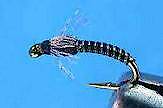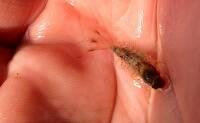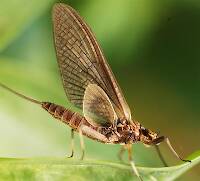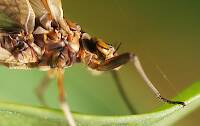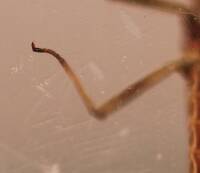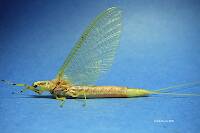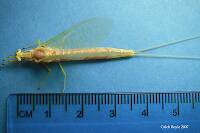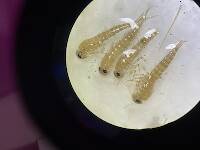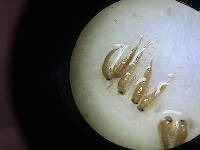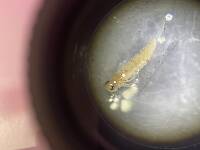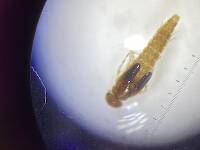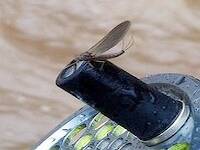
Blue-winged Olives
Baetis
Tiny Baetis mayflies are perhaps the most commonly encountered and imitated by anglers on all American trout streams due to their great abundance, widespread distribution, and trout-friendly emergence habits.
Featured on the forum

This species was fairly abundant in a February sample of the upper Yakima.

Troutnut is a project started in 2003 by salmonid ecologist Jason "Troutnut" Neuswanger to help anglers and
fly tyers unabashedly embrace the entomological side of the sport. Learn more about Troutnut or
support the project for an enhanced experience here.
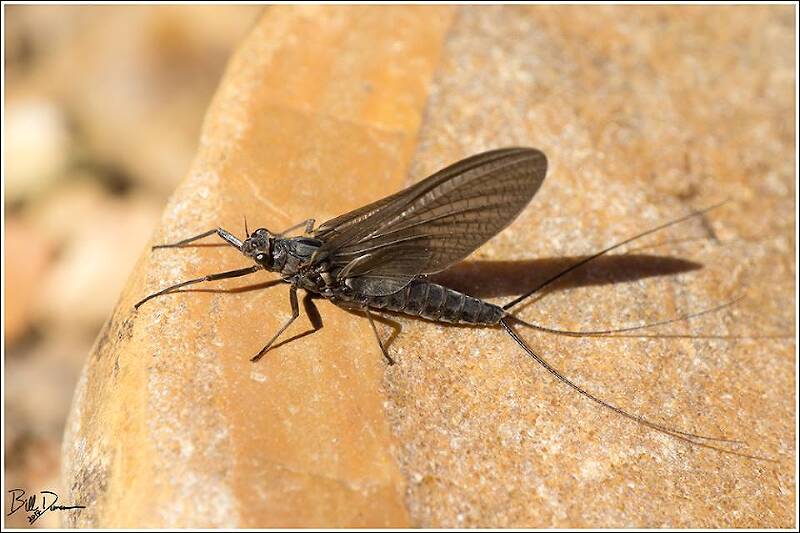
Troutal on Mar 6, 2017March 6th, 2017, 6:11 am EST
This mayfly was collected on the Big Piney River in Missouri during March, 2017. Would like to know genus and or species. Thinking it might be a Ephemerella subvaria (Dark Hendrickson) or a Paraleptophlebia adoptiva (Blue Quill).
Oh, thrilling the rise to the lure that is dry, when the shy fish comes up to his slaughter.
Yet rather would I have the turn to my fly. with a cunning brown wink under water.
The bright little wink under water! Mysterious wink under water!
Delightful
Yet rather would I have the turn to my fly. with a cunning brown wink under water.
The bright little wink under water! Mysterious wink under water!
Delightful
Wbranch on Mar 6, 2017March 6th, 2017, 11:15 am EST
I'm just a fly fisher and not one of the bug gurus on this forum but it surely doesn't look like any Ep subvaria I have ever seen.
Here is a link to Ep subvaia photographs that can be found on this web site if you click on "Aquatic Insect Encyclopedia", select "Mayflies" and then then the heading for Ephemeralla.
http://www.troutnut.com/specimen/494
Here is a link to Ep subvaia photographs that can be found on this web site if you click on "Aquatic Insect Encyclopedia", select "Mayflies" and then then the heading for Ephemeralla.
http://www.troutnut.com/specimen/494
Catskill fly fisher for fifty-five years.
Millcreek on Mar 6, 2017March 6th, 2017, 4:04 pm EST
I would agree with Matt that it is not E. subvaria but for different reasons. His link to E.subvaria is for male duns. The female duns are quite different and some do show a resemblance to the photo. Both male and female have a costal projection on the rear wing which I don't see in the photo.
It seems to be a Paraleptophlebia sp. as far as I can tell. Same overall color and the rear wing seems to be shaped and have the same venation as a Paraleptophlebia.
EDIT- Could be a Leptophlebia as well. http://bugguide.net/node/view/768092/bgpage
It seems to be a Paraleptophlebia sp. as far as I can tell. Same overall color and the rear wing seems to be shaped and have the same venation as a Paraleptophlebia.
EDIT- Could be a Leptophlebia as well. http://bugguide.net/node/view/768092/bgpage
"If we knew what it was we were doing, it would not be called research, would it?"
-Albert Einstein
-Albert Einstein
Taxon on Mar 6, 2017March 6th, 2017, 5:01 pm EST
Hi Mark-
I suspect this female subimago may be of genus Leptophlebia. Are you seeing something in the wing venation that would eliminate that as a possibility?
I suspect this female subimago may be of genus Leptophlebia. Are you seeing something in the wing venation that would eliminate that as a possibility?
Millcreek on Mar 6, 2017March 6th, 2017, 5:08 pm EST
Roger- You're probably right about it's being a Leptophlebia . I'd just given it some thought and gone to Bugguide. I came up with the link in the previous post.
Mark
Mark
"If we knew what it was we were doing, it would not be called research, would it?"
-Albert Einstein
-Albert Einstein
Crepuscular on Mar 6, 2017March 6th, 2017, 11:23 pm EST
I'm thinking Leptophlebia sp. as well. Color seems wrong for L. cupida. But we all know that color is not worth much as a determining character, too much variation out there. That, and the fact that we are looking at a female subimago, prevents me from saying anything past genus with any kind of confidence.
Troutal on Mar 7, 2017March 7th, 2017, 8:14 am EST
I just joined this forum and posted the identification of this mayfly as my first. Thank you for the responses and help. Hope I can have some helpful input down the road.
Oh, thrilling the rise to the lure that is dry, when the shy fish comes up to his slaughter.
Yet rather would I have the turn to my fly. with a cunning brown wink under water.
The bright little wink under water! Mysterious wink under water!
Delightful
Yet rather would I have the turn to my fly. with a cunning brown wink under water.
The bright little wink under water! Mysterious wink under water!
Delightful
Taxon on Mar 7, 2017March 7th, 2017, 9:28 am EST
Hi Al-
Please introduce yourself. Who is Bill D... (the name on the photo). A PM has been sent to you regarding the Homepage hyperlinked from your profile.
Best regards,
Please introduce yourself. Who is Bill D... (the name on the photo). A PM has been sent to you regarding the Homepage hyperlinked from your profile.
Best regards,
Troutal on Mar 8, 2017March 8th, 2017, 2:43 am EST
The photographer of the mayfly is a guy who was fly fishing on the Big Piney River in Missouri. He captured the mayfly and has little knowledge of entomology. He had a friend post the picture on the Ozark Fly Fishers Yahoo Group hoping to have it identified. I am a member of the group and became involved in trying to identify the mayfly. The photographer is Bill Duncan and can be reached at dfcurr@hotmail.com
Oh, thrilling the rise to the lure that is dry, when the shy fish comes up to his slaughter.
Yet rather would I have the turn to my fly. with a cunning brown wink under water.
The bright little wink under water! Mysterious wink under water!
Delightful
Yet rather would I have the turn to my fly. with a cunning brown wink under water.
The bright little wink under water! Mysterious wink under water!
Delightful
Troutnut on Mar 8, 2017March 8th, 2017, 6:02 pm EST
I think Roger got this one right -- Leptophlebia.
Jason Neuswanger, Ph.D.
Troutnut and salmonid ecologist
Troutnut and salmonid ecologist
PaulRoberts on Mar 9, 2017March 9th, 2017, 12:37 am EST
Crepuscular on Mar 9, 2017March 9th, 2017, 2:13 am EST
Troutal, This genus is a problematic one for adult identification. Especially when you have only a photo of a female subimago to go by. One of the most widely distributed and common species is L. intermedia so this may be your specimen but, they are very similar to a few other spp. of Leptophlebia so really going past the genus determination is all speculation. Not that, that has ever stopped us here ;). All I'm saying is that to get anymore positive of an identification is extremely difficult under good circumstances.
Konchu on Mar 27, 2017March 27th, 2017, 5:31 am EDT
Something about the tails bothers me a little about it being Leptophlebia. Most of those I see out this time of year have the middle tail shorter than the side tails. I could be having a moment.
Crepuscular on Mar 29, 2017March 29th, 2017, 12:26 am EDT
Something about the tails bothers me a little about it being Leptophlebia. Most of those I see out this time of year have the middle tail shorter than the side tails. I could be having a moment.
Hey Konchu! nice to hear from you! This place has been a little slow as of late. You don't think the middle one is shorter than the others? kinda hard to tell because of the angle of the photo, but to me it looks reduced. The base looks to be thicker on the two outside filaments, which to me, is another clue that that they are longer. If it's not, then what?
Jmd123 on Mar 29, 2017March 29th, 2017, 1:04 am EDT
The middle tail is definitely shorter than the outer two, I can clearly see it in both photos. There's a funny little line on the rock underneath that gives the illusion, in the 2nd photo, that the middle one is longer. Hope this helps solve your dilemma!
;oD
Jonathon
P.S. Can't wait to see something in this order flying around here...still pretty chilly in these parts, a bit warmer downstate.
;oD
Jonathon
P.S. Can't wait to see something in this order flying around here...still pretty chilly in these parts, a bit warmer downstate.
No matter how big the one you just caught is, there's always a bigger one out there somewhere...
Crepuscular on Mar 30, 2017March 30th, 2017, 2:51 am EDT
The middle tail is definitely shorter than the outer two, I can clearly see it in both photos. There's a funny little line on the rock underneath that gives the illusion, in the 2nd photo, that the middle one is longer.
The Id request was only for the original photo. I believe the second photo was posted for illustrative purposes.
Quick Reply
Related Discussions
Topic
Replies
Last Reply
1
Aug 30, 2010
by GONZO
by GONZO


